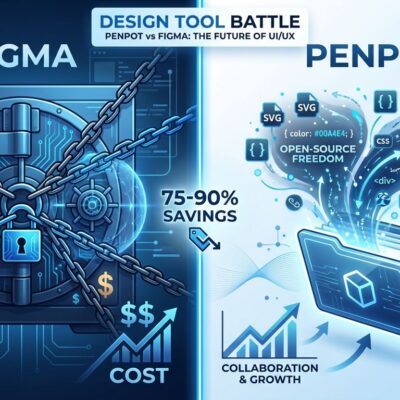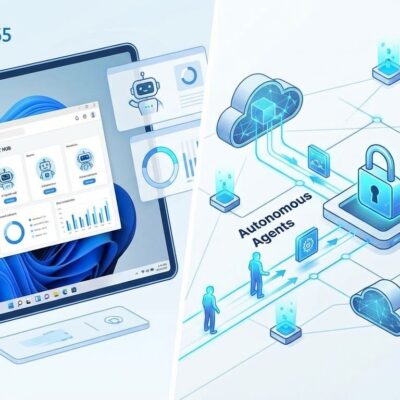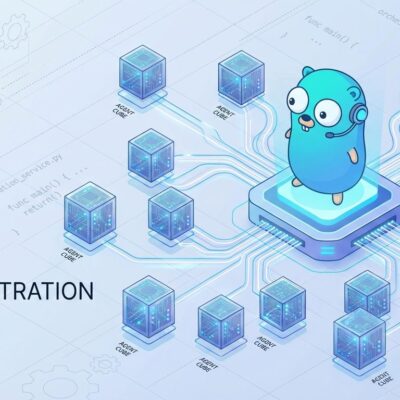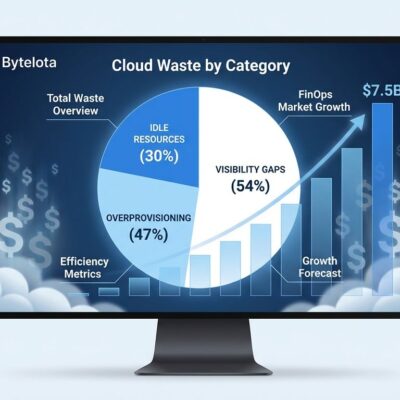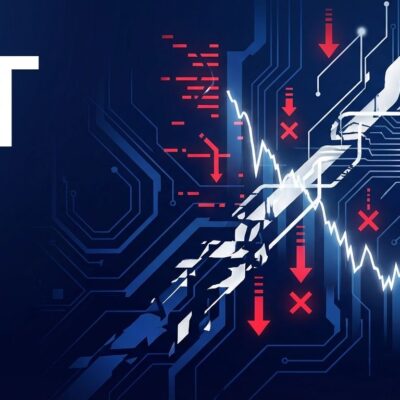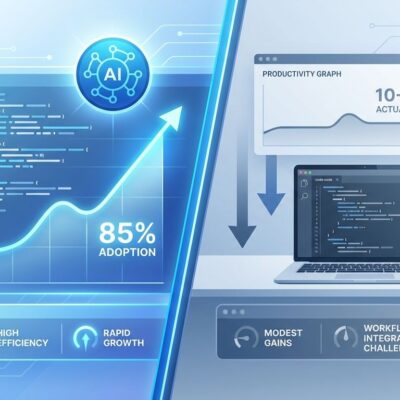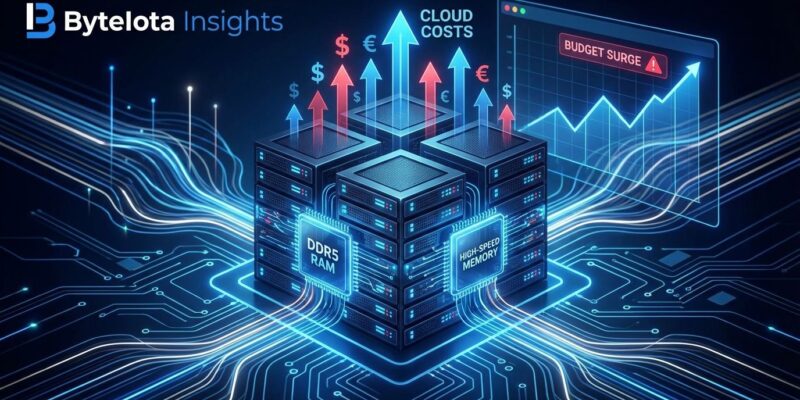
Cloud providers are preparing to raise prices 5-10% in 2026, and the culprit is not greed. It is physics. OVH CEO Octave Klaba announced November 24 that cloud prices will rise 5-10% between April and September 2026, driven by an unprecedented memory shortage. DDR4 prices surged 158% since September, DDR5 jumped 307%, and server costs will increase 15-25% by year-end. Meanwhile, Microsoft eliminated volume discounts November 1, hitting large enterprises with up to 12.83% cost increases. With 82% of companies already reporting budget overruns, the 2026 cloud cost crisis is arriving right on schedule.
AI Demand Broke the Memory Market
The memory shortage is not temporary. It is structural. DRAM contract prices increased 171.8% year-over-year as of Q3 2025, with DRAM prices now outpacing the recent price increases of gold. Some spot prices rose 300-1000% from early 2025 levels.
Memory manufacturers shifted production to meet AI hardware demand. They reallocated more than three times the wafer capacity to produce HBM (High Bandwidth Memory) chips for GPUs compared to conventional DRAM. Samsung and SK Hynix diverted advanced node capacity toward parts for AI acceleration. Conventional DDR5 RDIMM demand outpaced supply. DDR4, defying typical end-of-life decline, surged in price due to artificial supply constraints and panic stockpiling.
ADATA chairman Chen Libai predicts 2026 will see severe DRAM shortages. Analysts expect this pricing trend to continue for at least four years—the length of supply contracts Samsung and SK Hynix have signed with major buyers. Cloud providers have no choice but to pass these costs to customers. OVH forecasts identical servers will be 15-35% more expensive in December 2026 compared to December 2025.
Microsoft Eliminated Volume Discounts While Costs Surged
Microsoft’s timing could not be worse for customers. Effective November 1, 2025, Microsoft eliminated volume-based waterfall pricing discounts for Enterprise Agreement (EA) and MPSA customers across Microsoft 365, Azure, Dynamics 365, Power Platform, Defender, and GitHub.
Previously, Level B+ customers received 6-12% off list price based on volume tiers. Now everyone pays the same price whether buying 500 licenses or 50,000. Level D enterprises—the largest organizations—face up to 12.83% cost increases when their EA renews.
For a $30 million annual EA, that is an extra $3.85 million per year, or $11.5 million over a three-year term for the same products and quantities. The change hits on EA renewal after November 1 or when adding new online services not already on the price sheet. Existing contracts remain unchanged mid-term, but the clock is ticking.
This policy shift coinciding with infrastructure cost surges delivers a double hit. Large enterprises lose negotiating leverage precisely when memory shortages drive baseline costs higher. Budget planning for 2026 renewals has become chaos.
Hidden Costs Already Crushing Budgets
The pain is not waiting for 2026. It is already here. According to 2025 surveys, 82% of companies report higher-than-expected cloud bills, and 37% say cloud costs are now one of their top three budget concerns. Cloud budgets already exceed limits by 17%. Worse: 33% of businesses overrun their cloud budget by 40%.
Egress fees hide in plain sight. IDC studies show egress fees account for 6% of total cloud storage spending. Gartner reports egress fees can reach 10-15% of total cloud costs, sometimes more depending on usage patterns. A staggering 62% of IT leaders exceeded budgets due to unexpected egress fees. AWS charges up to $0.09 per gigabyte for data transfer out. Cross-region transfers, multi-cloud architectures, backups, and replication operations all trigger charges.
By making egress expensive, providers subtly encourage vendor lock-in. Moving data out costs so much that businesses become disincentivized from switching platforms. The egress fee trap is architectural: the more distributed your infrastructure, the more you pay for data movement.
Current budget overruns exist before 2026 price increases hit. Many companies remain unaware of egress fee impact until bills arrives. The 2026 increases will compound an already broken budgeting process.
Cloud Providers Offer Tools, But You Must Act
Cloud providers are responding with cost management tools. On November 19, 2025, AWS launched the Cost Efficiency metric in Cost Optimization Hub. It automatically calculates the percentage of cloud spend that can be optimized by considering rightsizing, idle resources, and commitment recommendations. The formula: Cost efficiency = [1 – (Potential Savings / Total Optimizable Spend)] × 100%.
The metric updates daily based on rolling 30-day spend and current savings opportunities. When you first enable it, you see 90 days of historical data. It covers EC2, RDS, ElastiCache, and other services. The tool provides visibility but does not fix anything automatically. You must act on recommendations.
The FinOps market reflects growing urgency. The global cloud FinOps market was valued at $1.7 billion in 2023 and is projected to grow at a 14.7% CAGR through 2032. Companies that implement FinOps practices report average 30% cost reductions. However, projections suggest $44.5 billion in infrastructure cloud waste in 2025 due to disconnects between FinOps and development teams.
Tools exist. Savings are possible. But optimization requires proactive effort. Waiting for 2026 increases without optimization guarantees budget disaster.
What Developers Should Do NOW
The 2026 price increases are inevitable. You cannot avoid them. You can only optimize around them. Companies are already cutting 20-40% through optimization strategies, according to industry reports. Gartner research shows managing egress costs alone reduces spending up to 30%. Here is what developers should do immediately:
Audit current spend. Use AWS Cost Efficiency, Azure Cost Management, or GCP cost tools to identify waste. Most organizations discover resources overprovisioned by 40% or more.
Eliminate idle resources. This is the easiest win and the most overlooked. Turn off unused instances. Stop paying for compute you are not using.
Rightsize workloads. Review instance types and sizes. Many workloads run on instances far larger than necessary. Rightsizing delivers immediate savings without architectural changes.
Tackle egress fees. Implement CDNs to cache content closer to users. Use data compression. Leverage private IP addresses for internal transfers. Minimize cross-region data movement. Each strategy reduces egress charges significantly.
Lock in pricing. Purchase Reserved Instances or Savings Plans now before price increases hit. Lock in current pricing for 1-3 years. Waiting until April 2026 means paying higher baseline rates.
Budget for 2026. Add 10-15% buffer to cloud budgets for price increases plus hidden costs. EA renewals after November 1, 2025 lose volume discounts. Factor those increases into planning.
Cross-functional collaboration is critical. FinOps best practices emphasize bridging finance, IT, and engineering teams with shared cost responsibility and transparent reporting. Automation and AI enable real-time cost monitoring and anomaly detection without manual processes that do not scale.
The planning window is closing. April-September 2026 brings price increases. Memory shortages continue through 2026 and beyond, with a four-year outlook according to supply contract timelines. EA renewals after November 1, 2025 trigger volume discount elimination. Early action provides more options. Waiting until April 2026 leaves you stuck with higher baseline costs and fewer levers to pull.
The 2026 cloud cost surge is a perfect storm of memory shortages, policy shifts, and infrastructure constraints. But it is not a mystery. The data is clear. The timeline is known. Companies that act now—audit spend, eliminate waste, rightsize workloads, tackle egress fees—can offset much of the coming increases. Companies that wait will pay the full price.

